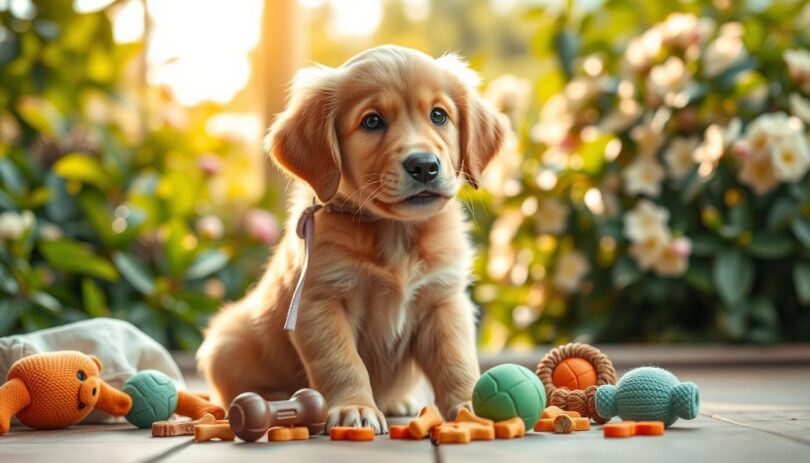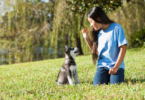Did you know that 70% of puppy owners report that early training helps reduce behavioral issues later in life? Bringing home a new puppy is an exciting milestone, but it also comes with significant responsibilities. Proper training is crucial for setting the right foundation and ensuring your puppy grows into a well-behaved dog.
Early training not only prevents future behavioral problems but also strengthens the bond between you and your puppy. This guide offers expert-approved advice, from basic obedience to advanced strategies, to help you navigate the journey of raising a well-adjusted dog. Drawing insights from reputable sources like The Puppy Academy and expert socialization methods, we’ll cover everything you need to know.
The keys to successful puppy training are consistency, a proper daily schedule, and positive reinforcement. By following these principles, you can help your puppy learn faster and behave better. This guide is designed for pet parents in the United States seeking trustworthy, comprehensive information.
We’ll provide practical tips and step-by-step instructions, making even complex training concepts easy to understand. Whether you're dealing with housebreaking, crate training, or socialization, our expert guidance will help you every step of the way.
Understanding the Foundations of Puppy Training
Early training is essential for setting your puppy on the path to becoming a well-behaved adult dog. Puppies as young as eight weeks old can begin learning basic commands, laying the groundwork for a strong foundation in obedience and good behavior. This early start not only helps with socialization but also strengthens the bond between you and your puppy.
The Importance of Early Training
Starting training early ensures that your puppy learns essential cues and commands, such as sitting and coming when called. These basic skills are the building blocks for more complex behaviors later in life. Consistency and patience are key; they help your puppy understand what is expected and create a positive learning environment.
Benefits of Consistency and Patience
Positive reinforcement, such as using treats or praise, encourages good behavior and helps your puppy associate actions with rewards. Short, engaging training sessions are effective and fun for your puppy. Remember, every interaction is a learning opportunity, so consistency and patience will yield the best results.
Setting Up a Puppy-Friendly Home Environment
Creating a safe and welcoming space for your new puppy is crucial for their development and your peace of mind. A well-structured environment not only aids in training but also reduces potential hazards that could harm your dog.
Puppy-proofing your home is the first step. Secure loose wires, toxic substances, and fragile items out of reach. Designate a quiet area for your puppy to rest and learn, ensuring it's free from distractions. This dedicated space helps your puppy focus during training sessions and relax during naps.
A consistent daily schedule is key to successful training. Establish fixed times for feeding, potty breaks, and play. This routine helps your puppy feel secure and makes house training easier. Use tools like crates and pet gates to create defined areas, aiding in potty training and reducing accidents.
A crate can serve as a safe haven for your puppy, providing a sense of security. Introduce it gradually, making it a comfortable space with familiar bedding. This helps with potty training and prevents destructive behavior when you're not home. Over time, your puppy will view the crate as a cozy retreat.
Setting up your home thoughtfully ensures a smooth transition for both you and your puppy. By creating a structured, safe environment, you lay the groundwork for effective training and a happy, healthy dog.
Basic Puppy Training: Essential Commands
Mastering basic commands is the cornerstone of effective puppy training. These foundational skills not only help with daily interactions but also lay the groundwork for more advanced training. By teaching your puppy simple cues like “sit,” “stay,” and “come,” you create a strong bond and set them up for future success.
Teaching Sit, Stay, and Come
To teach your puppy to “sit,” start by holding a treat above their head. Slowly move the treat backward towards their tail. As they follow the treat with their nose, they'll naturally sit down. Once they’re in the sitting position, say “sit” and give them the treat. Repeat this process until they learn the command.
For “stay,” begin with your puppy in a sitting position. Take a few steps back and say “stay.” If they get up, go back to the beginning. Gradually increase the distance and time you’re away. Reward them with a treat when they successfully stay in place. This helps them understand the command and builds patience.
The “come” command is vital for safety. In a quiet area, call your puppy by their name followed by “come.” When they approach, reward them with a treat and praise. Over time, increase the distance and add distractions to help them learn to respond reliably.
Building a Strong Human-Puppy Bond
Positive reinforcement is key to building trust. Use treats and praise to reward good behavior, reinforcing the connection between actions and rewards. Consistency in commands helps your puppy understand what’s expected, fostering a strong bond. By combining clear cues with positive outcomes, you create a foundation of trust and understanding.
These early lessons are more than just commands—they’re the building blocks for a well-behaved and confident dog. With patience, consistency, and positive reinforcement, you’ll help your puppy grow into a loyal and loving companion.
Housebreaking and Potty Training for Puppies
Housebreaking is one of the most critical aspects of raising a puppy. It’s a process that requires patience, consistency, and understanding of your puppy’s needs. By establishing a reliable routine and recognizing your puppy’s signals, you can help them learn where and when it’s appropriate to go potty.
Establishing a Reliable Potty Schedule
A consistent schedule is key to successful potty training. Puppies thrive on routine, so taking your puppy outside at the same times each day—such as after meals, playtime, or naps—helps them learn when it’s time to go. As a general rule, puppies can hold their bladder for about one hour for every month of their age. For example, a 4-month-old puppy can typically wait up to four hours. However, younger puppies may need more frequent trips outside.
Recognizing Your Puppy's Cues
Puppies often exhibit specific behaviors when they need to go potty. They may sniff the ground, circle, or squat. Learning these cues allows you to act quickly and guide your puppy to the right spot. If you see these signs, immediately take your puppy to the designated potty area. Positive reinforcement with treats and praise when they go potty outside will help reinforce good behavior.
Remember, accidents will happen, especially in the early stages. If your puppy has an accident indoors, clean the area thoroughly with a neutral-smelling cleaner to remove any lingering scents that might attract them to the same spot again. Avoid punishment, as it can create anxiety and make the process harder. Instead, focus on rewarding good behavior and adjusting your schedule as needed.
As your puppy grows and gains more bladder control, you can gradually extend the time between potty breaks. Stay patient and consistent, and remember that every puppy learns at their own pace.
Crate Training: Creating a Safe Space
Crate training is a valuable tool for creating a safe and comfortable environment for your puppy. By tapping into their natural denning instincts, a crate provides a sense of security and can aid in housebreaking while reducing destructive behaviors.
Introducing Your Puppy to the Crate
Start by placing the crate in a high-traffic area to keep your puppy feeling included. Use treats to encourage them to enter voluntarily. Once they’re comfortable, begin feeding meals inside with the door open to build a positive association. This gradual introduction helps your puppy view the crate as a welcoming space.
Building Comfort and Security
Once your puppy is comfortable entering the crate, start closing the door during meals. Begin with short periods and gradually increase the duration. Never use the crate as punishment, as this can create negative associations. Add a soft bed or familiar toy to make the space cozy, ensuring your puppy sees the crate as a safe haven.
A properly set-up crate not only aids in training but also eases separation anxiety, making it an essential part of raising a well-adjusted puppy.
Reward-Based Training: Tips for Success
Reward-based training is a powerful approach that harnesses the effectiveness of treats, toys, and praise to encourage desired behaviors in puppies. This method not only motivates your puppy to learn but also strengthens the bond between you and your furry friend.
Using Treats for Positive Reinforcement
Treats are a cornerstone of reward-based training. Choose small, low-calorie options to avoid overfeeding while keeping your puppy engaged. Timing is crucial—deliver the treat immediately after the desired behavior to create a clear association. For instance, when teaching “sit,” offer the treat the moment their bottom touches the floor. Vary the treats to maintain interest and excitement, ensuring each reward feels like a new accomplishment.
Incorporating Toys and Praise
Toys and praise add depth to your reward system. A favorite toy can be a powerful motivator, especially for puppies that are highly playful. Verbal praise, such as saying “good boy!” in an upbeat tone, reinforces positive behavior without relying solely on treats. Mixing these rewards keeps training sessions dynamic and engaging, preventing boredom and ensuring your puppy stays focused.
Socialization Strategies for a Confident Puppy
Socialization is a cornerstone of raising a confident and well-adjusted puppy. It’s a process that shapes their behavior and helps them navigate the world with ease. Proper socialization introduces your puppy to new people, pets, and environments, laying the groundwork for a calm and curious temperament.
Meeting New People and Pets
Introducing your puppy to various people and pets is essential. Start with small, controlled interactions, such as family gatherings, where your puppy can meet new faces in a safe setting. Puppy socialization classes are also a great way to expose your dog to other puppies and people. These classes not only aid in social development but also provide a structured environment for learning basic cues.
When introducing your puppy to other dogs, opt for one-on-one interactions to ensure a positive experience. This approach helps prevent overwhelming situations and allows your puppy to build confidence gradually. Remember, every positive encounter strengthens their social skills and reduces the likelihood of fear-based behaviors later in life.
Exploring Various Environments
Exposure to different environments is crucial for your puppy’s development. Begin with quiet, low-distraction areas like parks or sidewalks. Gradually introduce busier settings, such as shopping districts or pet stores, to help your puppy become confident in varied situations. Each new environment should be explored at your puppy’s pace, allowing them to process sights, sounds, and smells without feeling overwhelmed.
Wait until your puppy’s vaccinations are complete before exposing them to high-traffic areas. Once it’s safe, take them on outings to experience different surfaces, such as grass, concrete, and wood floors. These experiences help build their confidence and reduce the likelihood of fear or anxiety in new situations.
A well-socialized puppy is better equipped to handle life’s challenges. By introducing them to a variety of people, pets, and environments, you set the stage for a lifetime of confidence and curiosity. Remember, every positive experience contributes to a well-adjusted and happy adult dog.
Developing an Effective Daily Training Schedule
A well-structured daily schedule is key to helping your dog thrive. By organizing potty breaks, playtime, and rest, you create a routine that supports steady growth and learning. This consistent approach ensures your dog feels secure and develops good habits from an early age.
Regular, short training sessions keep your dog engaged without causing boredom. These frequent, focused moments help reinforce lessons and build a strong foundation. Syncing feeding times with potty breaks and training sessions creates a predictable routine that your dog can easily follow.
Using a printable schedule or digital calendar can help track progress and maintain consistency. This consistency reduces anxiety and boosts learning efficiency. As your dog grows, adjust the schedule to meet their evolving needs, ensuring it remains flexible without losing structure.
Expert trainers suggest incorporating flexibility into the routine, allowing for spontaneous play or unexpected potty breaks. This balance keeps the schedule effective without becoming rigid. By sticking to a daily plan while allowing for adjustments, you create a nurturing environment that supports your dog's development.
Mastering Leash Training for Outdoor Adventures
Leash training is essential for safe and enjoyable outdoor adventures with your dog. It helps prevent unwanted behaviors like pulling or lunging, ensuring a pleasant experience for both you and your furry friend.
Encouraging Proper Leash Behavior
Start by introducing the leash indoors. Let your dog get used to wearing a collar and leash in a controlled environment. Use treats and verbal cues to encourage calm behavior. Once they're comfortable, move to quiet outdoor areas with fewer distractions.
Transitioning to Busy Outdoor Settings
Gradually expose your dog to busier environments, like parks or sidewalks. Use the stop-and-go method to manage pulling. When your dog pulls, stop walking until they relax. Reward them when they walk beside you calmly. This teaches them that pulling doesn’t lead to progress.
Consistency is key. Keep training sessions short and structured. Use positive reinforcement with treats and praise to reinforce good leash manners. Over time, your dog will learn to walk calmly by your side, making outdoor adventures more enjoyable for everyone.
puppy training techniques: Advanced Tips and Strategies
As your puppy grows, it’s time to expand their skill set with advanced training techniques. These strategies will challenge your puppy, strengthen your bond, and prepare them for real-world situations. Whether you're introducing new cues or navigating busy environments, consistency and positive reinforcement remain key.
Introducing Advanced Cues
Advanced cues like “stay close” and “heel” build on basic commands. Start by introducing one new cue at a time, ensuring your puppy understands each before moving on. Use positive reinforcement with treats and praise to encourage learning. For example, teaching “heel” involves walking with your puppy at your side without pulling on the leash. Reward them when they maintain the correct position.
Managing Distractions Effectively
Distractions are inevitable, but with the right approach, your puppy can learn to focus. Begin training in quiet areas with minimal distractions. Gradually introduce busier environments, rewarding your puppy for maintaining focus. If they struggle, return to simpler settings and slowly rebuild their confidence. Consistency and patience are crucial in helping your puppy navigate distractions effectively.
Overcoming Common Puppy Training Challenges
Every dog owner faces challenges during training, but knowing how to address them is key to success. Common issues like behavioral setbacks or consistency lapses can hinder progress, but with the right approach, you can overcome them. Positive reinforcement and patience are essential in these situations.
Troubleshooting Behavioral Issues
Identifying the root cause of behavioral problems is the first step. For example, if your puppy is having accidents indoors, it might be due to an inconsistent schedule. Positive reinforcement can help correct this by rewarding good behavior. Experts suggest using treats and praise to encourage desired actions, avoiding punishment which can lead to anxiety.
Maintaining Consistency Through Setbacks
Consistency is crucial, even when faced with setbacks. If a training session goes poorly, reset by ending on a positive note. This helps maintain your puppy's confidence. Experts recommend short, focused sessions to keep your puppy engaged and prevent frustration.
Understanding your puppy's signals allows for quick interventions. For instance, if your puppy starts showing signs of fear during socialization, calmly redirect their attention to a familiar command. Patience and routine are vital in overcoming challenges and fostering a well-behaved dog.
For persistent issues, consulting a professional trainer can provide tailored solutions. Remember, every puppy learns at their own pace. With consistent effort and positive reinforcement, you can help your puppy overcome any obstacle and thrive.
Final Thoughts on Shaping a Well-Behaved Pup
Shaping a well-behaved pup requires dedication, patience, and the right approach. As you conclude this guide, remember that every small tip and step contributes to long-term success. Consistency and positive reinforcement are key to helping your dog grow into a confident and well-adjusted adult.
Adapt your training methods as your pup grows and develops. Whether it's refining potty training or introducing new cues, every step brings you closer to your goal. Make sure to keep positive reinforcement at the core of all interactions, rewarding good behavior with treats, praise, or play.
For lasting results, stay patient and persistent. Every training session, no matter how small, builds a stronger bond between you and your dog. If challenges arise, don't hesitate to seek advice from professional trainers or explore additional resources.
With time and effort, you'll raise a dog that's not only well-behaved but also happy and fulfilled. Happy training!











Leave a Comment